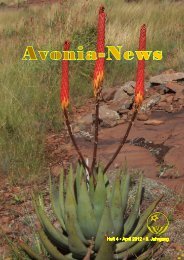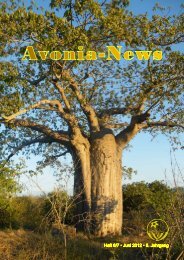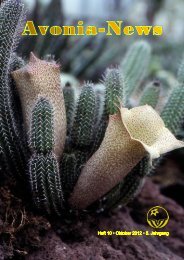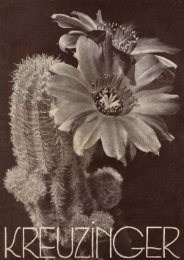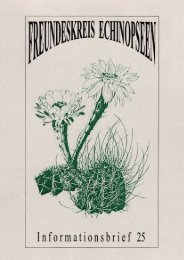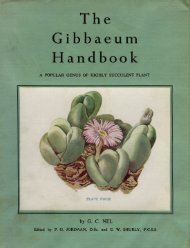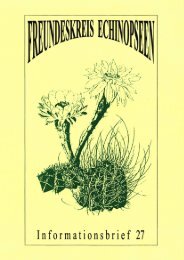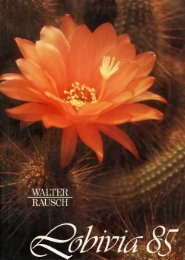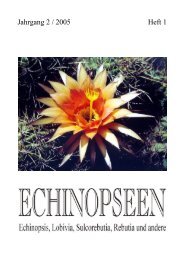VOLUME 14 :: January—October, 1952 Illustrations shown in ...
VOLUME 14 :: January—October, 1952 Illustrations shown in ...
VOLUME 14 :: January—October, 1952 Illustrations shown in ...
You also want an ePaper? Increase the reach of your titles
YUMPU automatically turns print PDFs into web optimized ePapers that Google loves.
THE CACTUS AND SUCCULENT January, <strong>1952</strong><br />
CULTIVATION OF SUCCULENTS<br />
By W. DENTON, B. E. M.<br />
Although these notes are due to appear <strong>in</strong> the January issue of our Journal, one has to th<strong>in</strong>k about the subject<br />
well <strong>in</strong> advance of this date. I have never known such a late season for the flower<strong>in</strong>g of stemless Mesembs. On<br />
the 10th October I noted the follow<strong>in</strong>g Lithops <strong>in</strong> flower : terricolor, peersii, verruculosa, helmuti, comptonii, fulviceps,<br />
bella, karasmontana ; numbers of others have buds just appear<strong>in</strong>g and I am afraid will not develop fully as they<br />
must have sunsh<strong>in</strong>e to give of their best. The Conophytums are <strong>in</strong> bloom and make a brave show. The follow<strong>in</strong>g<br />
are full out on the same date : pellucidum, polyandrum, exertum, tumidum, notabile, wettste<strong>in</strong>ii, etc.<br />
These are charm<strong>in</strong>g little plants that have a much larger colour range, compris<strong>in</strong>g shades of p<strong>in</strong>k, straw, deep<br />
yellow and white. It is a pity that the Lithops do not give us a few different colours, yellow and white are the only<br />
two ! know of <strong>in</strong> this genus. With me the Conophytums will be kept steadily grow<strong>in</strong>g through our w<strong>in</strong>ter till about<br />
March. This does not mean that you should water frequently, but just a little <strong>in</strong> the f<strong>in</strong>e spells we sometimes<br />
get <strong>in</strong> our w<strong>in</strong>ters. They are mak<strong>in</strong>g new roots now, a certa<strong>in</strong> amount of the old root<strong>in</strong>g system hav<strong>in</strong>g died away.<br />
September is a good time to take cutt<strong>in</strong>gs of these. For good results, great care should be taken to see they are<br />
trimmed right, numbers of the plants, after a few years, develop hard woody stems sometimes an <strong>in</strong>ch long and<br />
even more with the very old ones.<br />
Do not attempt to plant your cutt<strong>in</strong>g with a piece of the stem attached to it, it may not root at all. Cut back<br />
as close as possible to the growth, just leav<strong>in</strong>g enough to give you a scar. You will f<strong>in</strong>d they root well <strong>in</strong> Vermiculite<br />
or ord<strong>in</strong>ary compost. I do suggest that a layer of sand should be used on top of the compost for cutt<strong>in</strong>gs to go<br />
directly <strong>in</strong>to. They will f<strong>in</strong>d their way down to the good material soon enough. Unlike most of the stemless<br />
Mesembs., they are very shallow root<strong>in</strong>g subjects and do not require deep pots.<br />
Lithops will go to rest directly after flower<strong>in</strong>g with me and will rema<strong>in</strong> dry till about next May. Another<br />
<strong>in</strong>terest<strong>in</strong>g plant <strong>in</strong> flower with me at this date is Pleiospilos bolusii, this is reward<strong>in</strong>g me this year with eight flowers,<br />
it is one of my favourites, hav<strong>in</strong>g been <strong>in</strong> my possession twenty years and has four nice growths. I have had several<br />
queries about the cultivation of this plant dur<strong>in</strong>g the past season. It is very easy to manage and should be kept<br />
perfectly dry while the new leaves are develop<strong>in</strong>g, they are do<strong>in</strong>g so at the expense of the old ones. When these<br />
old stems persist <strong>in</strong> the form of dried sk<strong>in</strong>s, that is the time to give a little water. Unlike some others <strong>in</strong> this<br />
Family, there should never be more than two leaves present on each growth at the time of flower<strong>in</strong>g. When <strong>in</strong><br />
full growth, two leaves com<strong>in</strong>g and two go<strong>in</strong>g is the correct procedure. Pleiospilos nelii is a much more difficult<br />
plant and not nearly so free flower<strong>in</strong>g, or so I f<strong>in</strong>d it. It will, most times, throw a bud long before the old stem<br />
has died away and this always appears on new growth com<strong>in</strong>g, but still I never water this while the old stem is<br />
green and succulent. My plant of this is a fairly large one and I have not watered it at all this year, because of the<br />
four leaves present. In fairness, I should state that my plants are plunged <strong>in</strong> sand and frame grown and that I know<br />
there is always a certa<strong>in</strong> amount of dampness present under these conditions. I am not afraid of the plant dy<strong>in</strong>g<br />
for the want of water, however, they do not m<strong>in</strong>d a long dry spell.<br />
Both these plants have been <strong>in</strong> the same pots three years now and are due for an overhaul and re-pot next<br />
spr<strong>in</strong>g. I expect to f<strong>in</strong>d a certa<strong>in</strong> amount of root bug present, they are very subject to this pest. It is as well, at<br />
this time of the year, to go over the stemless Mesembs. and carefully remove any dead sk<strong>in</strong>s rema<strong>in</strong><strong>in</strong>g on the plants.<br />
A pair of blunt tweezers are suitable for this and care should be taken not to <strong>in</strong> any way <strong>in</strong>jure the new growths.<br />
My reason for this is, ow<strong>in</strong>g to our usually damp w<strong>in</strong>ters, these old growths sometimes absorb any atmospheric<br />
moisture present and this is liable, <strong>in</strong> some cases, to cause rot at the back of the plants. In their native habitats<br />
the atmosphere is always very dry and bright and, remember, they are out of doors and not under glass. On<br />
imported plants you can often count seven or eight, or even more, old sk<strong>in</strong>s and this gives you a good idea of the<br />
age of the specimen.<br />
You will f<strong>in</strong>d this clean<strong>in</strong>g up of old plants a slow, tedious job, especially with a clump of the small grow<strong>in</strong>g<br />
Conophytum types, but it is well worth it.<br />
I know that numbers of people will be us<strong>in</strong>g paraff<strong>in</strong> lamps for heat<strong>in</strong>g small greenhouses this year <strong>in</strong> lieu of<br />
electric tubular heaters which are subject to cuts <strong>in</strong> supply. These should be quite satisfactory if kept clean and<br />
the wicks trimmed frequently. It is better to use two smaller pieces of apparatus rather than one large one ;<br />
you can keep the flames low and avoid the draw<strong>in</strong>g up of the flame <strong>in</strong> a sudden warm spell. It is a very bad bus<strong>in</strong>ess<br />
to come out to look at your plants and f<strong>in</strong>d them covered with soot. This will only happen if you are runn<strong>in</strong>g<br />
them at top capacity.<br />
In my greenhouse I have a forty gallon tank filled under the stag<strong>in</strong>g. I keep this filled with ra<strong>in</strong> water which




